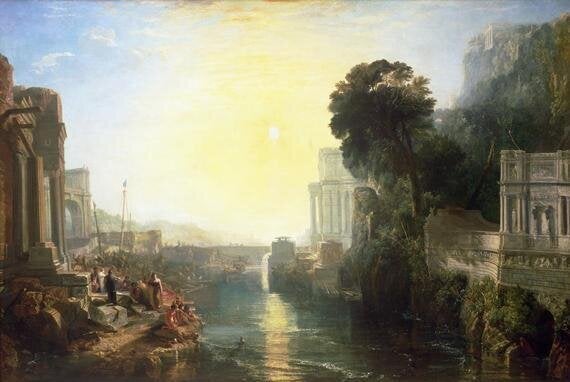Source: Artfinder
The artwork that’s getting us talking this week is J.M.W. Turner’s Dido Building Carthage, painted by the British romanticist in 1815.
Upon his death in 1851 the artist donated this painting – along with Sun Rising Through Vapour (before 1807) – to the National Gallery in London, on the condition that the works were hung between two of Claude Lorrain’s masterpieces, The Seaport and Landscape with the Marriage of Isaac and Rebecca.
These paintings form the cornerstone of the National Gallery’s current exhibition Turner Inspired: In the Light of Claude (14 March - 5 June 2012), and Dido Building Carthage is one of Turner’s more intriguing works.

Dido Building Carthage by J.M.W. Turner (1815), oil on canvas, National Gallery, London
If you look at this painting you’ll see more than one perspective: there’s the regular horizon line, however the perspective of the building to the right of the canvas does not meet up with this. Turner was experimenting with various viewpoints, asking us to take multiple journeys through the canvas to discover the landscape from many positions.
It’s odd that we look up on the buildings in the foreground, yet almost feel that we can look down on those in the centre distance. What first appears to be a classically ordered composition then turns into a sort of jigsaw puzzle, an extraordinary spatial game in which there are several pockets of space for us to explore.
His use of colour is also intriguing; vast washes of luminous yellows and intense greens have a transcendent and immaterial quality. These deep pools of colour do not create structure or fix the space – they seem to hover on the canvas and create fleeting effects of light. With these approaches to painting Turner layed the foundations of Impressionism and sowed the seed of what would eventually become abstract art.
Artyfacts:
- A quiet and reserved man, J.M.W. Turner would sometimes go by his mistress's name Booth to avoid attention
- Ruskin once described Turner as “the man who beyond all doubt is the greatest of the age”
- J.M.W. Turner had a favourable relationship with the Royal Academy, being its second youngest Academician and eventually becoming President
You can discover more of Turner’s art and its relationship to the French painter Claude at the National Gallery between now and June. To explore more of the two masters’ works, check out this collection from Artfinder: